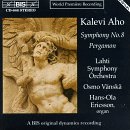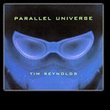| All Artists: Kalevi Aho, Osmo Vänskä, Lahti Symphony Orchestra, Hans-Ola Ericsson, Pauli Pietilainen Title: Aho: Symphony 8 / Pergamon Members Wishing: 0 Total Copies: 0 Label: Bis Release Date: 4/16/1995 Album Type: Import Genres: Special Interest, Classical Styles: Forms & Genres, Concertos, Symphonies Number of Discs: 1 SwapaCD Credits: 1 UPCs: 7318590006467, 789368054022, 078936805402 |
Search - Kalevi Aho, Osmo Vänskä, Lahti Symphony Orchestra :: Aho: Symphony 8 / Pergamon
 | Kalevi Aho, Osmo Vänskä, Lahti Symphony Orchestra Aho: Symphony 8 / Pergamon Genres: Special Interest, Classical |
Larger Image |
CD DetailsSimilar CDs
|
CD ReviewsAmazing music from a post-modern master Harlan Otter | Santa Cruz, CA United States | 09/15/2002 (5 out of 5 stars) "Kalevi Aho (b. 1949) has stated that his works have an "abstract plot" driving his music from behind the scenes. His series of (so far) eleven symphonies certainly testifies to this statement; each of his symphonies seems to set out from a fixed point, always to confront the impassable, and always trying to reconcile that conflict in the most poignant and personal of ways. I personally find Aho to be the most brilliant composer of his generation, assuredly handling all of his musical material with the utmost genius from the first bar to the last. Aho has particularly advanced the art of form and orchestration in music to a level of precision and detail which has (to my knowledge) not yet been equaled. His Symphony no. 8 is a perfect testament to all of this composer's many strengths. Aho combines his knack for original form and technicolor orchestration by putting the symphony's dramatic weight in three long, involving scherzi movements; between these come super-virtuosic interludes for an organ soloist, which seems to represent the ever-striving voice of an individual man against awe-inspiring nature (the orchestra). All movements are played without a break.Symphony no. 8 begins with one of the most atmospheric landscapes yet painted in music: an eerie, disconnected world of ominous buzzes and hazy strings, as if the music was imbued with a spark of self-consciousness but was still too delirious from non-existence to realize it. The music then progresses through Aho's highly original structure; although the "scherzi" certainly do capture the capricious feeling typically associated with that form, they more closely resemble the dark, expressive virtuoso vehicle first explored by Frederic Chopin. The scherzi's playfulness is implied rather than outright stated, and often that playful implication breaks down (or develops) into climaxes of terrifying majesty. Throughout the symphony, Aho's style traverses all the territory familiar to the post-modernist, from the aforementioned avant-garde opening, to forcefully grinding dissonance, to Shostakovichian passages tinged with ironic melodies and tart harmonies, to intimate lyricism which progresses to pages of the most immense lushness; the final portion of this symphony truly testifies to the pure serenity and beauty that our best composers can so compellingly create. Aho integrates all these diffuse elements so seamlessly that one forgets that music could in fact be classified as tonal or atonal in the first place. Symphony no. 8 is a work which, in following the Mahlerian tradition, truly attempts to embrace and express everything in our universe and overwhelmingly succeeds. The profound and the banal, the beautiful and ugly, the assured and the pathetic, and tonality and atonality completely complement each other within Aho's titanic framework. This symphony comes with the highest recommendations, sure to move any fan of music by Mahler, Sibelius, Shostakovich, or Schnittke.As for Pergamon, the "filler" piece on this album, the "abstract plot" is hardly abstract at all. In this work, Aho calls for four speakers reciting text from a monument dedicated to the victims of the Holocaust, accompanied by four stereophonically dispersed chamber ensembles. The musical portrayal is absolutely as blood-curdling as any of the best artistic odes to that tragedy; the world-embracing post-modernist is apparently on leave. No longer do we hear Aho's personal expressive voice, but instead a gruesome and violent world where darkness does not yield an inch (until the final, strangely consoling coda), a world painted in the starkest of avant-garde languages. Easily comparable to works like "Threnody to the Victims of Hiroshima," or "Black Angels," "Pergamon," explores human actions and emotions which are not always easy to stomach - yet the musical imagery is so powerfully vivid that the impact is truly emotionally arresting. As the brutal "Pergamon" is perhaps the perfect musical antithesis to the spiritually uplifting Symphony no. 8, this is perhaps an ideal CD for any first-time buyer interested in the music of this grossly underrated modern master."
|


